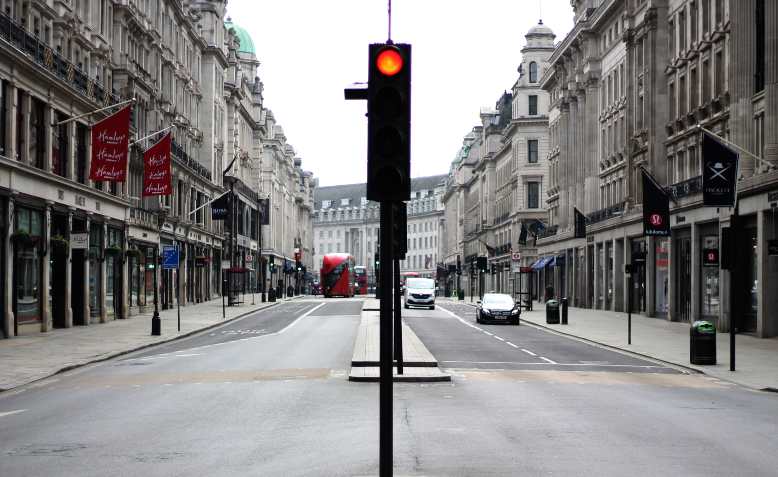 Regent Street, London, 27 April. Photo: Flickr/Domogwai
Regent Street, London, 27 April. Photo: Flickr/Domogwai
With the global economy facing the biggest downturn in 150 years, there will be no return to ‘normal’, argues Michael Roberts
As many countries in Europe and many states in the US begin to relax lockdown restrictions to contain the coronavirus, what sort of world economy will emerge? Of course, the lockdowns will not disappear overnight. Indeed, returning to work, opening up businesses and getting students back to school and college will only be gradual, while travel, especially plane flights (at least internationally) are still some way off. And as for mass events, entertainment etc, they will be the last to return.
That’s because the virus is not dead. So-called ‘herd immunity’, where a sufficient proportion of the population has been infected to curb or end the transmission of the virus, has not been achieved anywhere; and the availability of an effective vaccine is months, if not years, away.
But there is no alternative to ending the lockdowns because the virus is killing capitalism. All the major capitalist economies are diving into the worst slump in production, investment and employment for 150 years! The world economy was already slowing to a crawl with several countries in a recession before the pandemic broke. It was teetering on a cliff edge; the virus pushed the global economy over into a deep chasm.
So 2020 will be the first year of falling global GDP since WWII. US GDP will be close to 12% below its pre-virus level by the end of 2020. The UK economy will be some 14 per cent below its pre-recession trend.
Already 30m Americans have applied for unemployment benefit, and the unemployment rate everywhere will easily surpass the worst levels since the Great Depression of the 1930s. The situation will be even worse for the billions in the so-called developing economies of the Global South. Economic output in emerging markets is forecast to fall 1.5% this year, the first decline since reliable records began in 1951.
Of the total global working population of 3.3 billion, about 2 billion work in the “informal economy”, often on short-term contracts or self-employment. Of these, 1.6 billion face losing their livelihoods. Under the most serious scenario – a 20% contraction in income – the number of people living in extreme poverty would rise by 434 million people to 922 million worldwide. The World Bank reckons the pandemic will push sub-Saharan Africa into recession in 2020 for the first time in 25 years. Ken Rogoff, the former chief economist of the IMF, said:
“We’re looking at a commodity-price collapse and a collapse in global trade unlike anything we’ve seen since the 1930s”
Nevertheless, optimism reigns in many quarters that once the lockdowns are over, the world economy will bounce back on a surge of released ‘pent-up ‘ demand. People will be back at work, households will spend like never before and companies will take on their old staff and start investing for a brighter post-pandemic future. US Treasury Secretary Mnuchin claims that: “This is a short-term issue. It may be a couple of months, but we’re going to get through this, and the economy will be stronger than ever.”
But these optimists are not recognising that the Covid-19 pandemic is not generating a ‘normal’ recession and it is hitting not a just a single region but the entire global economy. Many companies, particularly smaller ones, will not return after the pandemic. Already several middling retail and leisure chains have filed for bankruptcy and airlines and travel agencies may follow.
But what about the humungous injections of credit and loans being made by the central banks around the world and the huge fiscal stimulus packages from governments globally. Won’t that turn things around quicker? The size of credit injections and fiscal packages globally has reached over 4% of GDP in fiscal stimulus and another 5% in credit injections and government guarantees. That’s twice the amount in the Great Recession.
The problem with these credit and fiscal stimulus measures are that they ignore the crucial factor: the social structure of capitalism. Under capitalism, production and investment are for profit, not for meeting the needs of people. And profit depends on the ability to exploit the working class sufficiently compared to the costs of investment in technology and productive assets. It does not depend on whether the government has provided enough ‘effective demand’. Much of the monetary and fiscal largesse will end up either not being spent but hoarded, or invested not in employees and production, but in unproductive financial assets, not in restoring jobs, businesses and investment.
Indeed, as the lockdowns end, millions of workers will be faced not with ‘business as usual’, but being told that their job is no longer there or that they must accept lower wages and/or longer hours because their employers cannot afford to go back to normal.
And then the huge debt that governments have incurred in trying to keep businesses and capitalism afloat will have to be paid for. A new round of austerity will be the aim of governments just when people will be demanding a properly funded public health service that can handle future pandemics, which surely will come. The struggle in the workplace and in the political arena will return with a vengeance.
Watch Michael Roberts and Susan Newman discussing the economic crisis and the socialist response at a recent Counterfire public meeting:
You can download Michael Roberts’ slides from his talk here.
Before you go
Counterfire is growing faster than ever before
We need to raise £20,000 as we are having to expand operations. We are moving to a bigger, better central office, upping our print run and distribution, buying a new printer, new computers and employing more staff.

